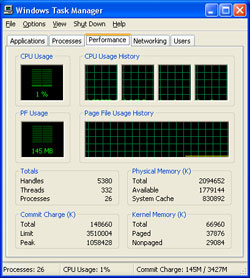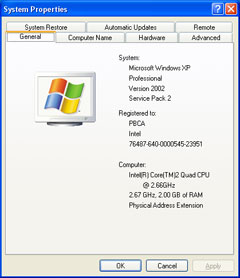Quad Cores: Intel Kentsfield Preview
by Anand Lal Shimpi on September 28, 2006 7:00 PM EST- Posted in
- CPUs
At this year's Spring IDF, before the launch of Intel's new Core 2 processors, in an unprecedented move (for Intel) we were allowed to benchmark the new Core 2 processor alongside an AMD system and publish benchmarks. While we've previewed Intel processors in the past before their launch, this was the first time we were able to test something this far in advance of its launch, with Intel's support, and also test a competing AMD part at Intel's own show. Previously, Intel would hardly even recognize that it had a competitor, but in the past year alone Intel's attitude towards competition has changed dramatically. The change in heart was also quite evident at this year's Fall IDF, where featuring competing AMD solutions on stage for performance comparisons was far from taboo.
Generally speaking, Intel had a lot of success with its early previews of the Core 2 processors. Readers could get a good idea of performance well before its launch and they could plan upgrades accordingly, and as it turned out, the final shipping performance of Core 2 CPUs was nothing short of impressive. With the November launch of its quad-core Kentsfield and Clovertown based processors quickly approaching, Intel offered members of the press a similar chance to take an early look at quad-core performance at IDF.
This time around there were only two systems, both of which were Intel based. There's no need for a reference AMD system since we've already determined that Intel's Core 2 Extreme processor is faster than anything AMD currently has to offer; what we're now interested in is how much of a performance improvement you can get from going to quad-core. Both systems were identically configured with 2GB of DDR2-800 running at 4-4-4-12 timings on an Intel BadAxe2 motherboard based on the 975X chipset.
Unfortunately, we weren't very pleased with the benchmarking circumstances this time around. When we tested Core 2 at last IDF, we were able to run some of our own benchmarks and the benchmarks represented a reasonable subset of the performance tests we were already running in house. With Intel's quad-core setup, we were not able to run any of our own benchmarks and the majority of the tests we were able to run were of benchmarks we wouldn't normally use to begin with. While we could adjust settings and use some of our own demos/test configurations last time, this time we couldn't do anything other than click go and see the results generated in real time. There's no reason to believe that Intel did anything fishy, and the performance we saw agreed with internal performance testing of Kentsfield, but overall the time benchmarking at IDF was not all that useful.
Keep in mind that the benchmarks Intel selected to show off were specifically chosen to maximize the impact of four cores, and thus we're looking at a lot of significantly multi-threaded applications like 3dsmax. Realistically, the majority of tests in our normal CPU benchmark suite will not see a benefit from quad-core and thus the real purchase decision between dual and quad core is far more difficult to make than you'd think based on these numbers alone. At the same time, when your options at $999 are a 2.93GHz Core 2 Extreme X6800 (dual-core) or a 2.66GHz Core 2 Extreme QX6700, we'd generally recommend going for the latter if you're multitasking at all or plan on running any applications that are well threaded. Even games like Alan Wake and Unreal Tournament 2007 will be able to take advantage of the extra cores, and you can always overclock the processor to make up for the clock speed difference, but you can't enable more cores than you have.
With the stage set, let's take a look at the actual performance Kentsfield brings to the table.
Generally speaking, Intel had a lot of success with its early previews of the Core 2 processors. Readers could get a good idea of performance well before its launch and they could plan upgrades accordingly, and as it turned out, the final shipping performance of Core 2 CPUs was nothing short of impressive. With the November launch of its quad-core Kentsfield and Clovertown based processors quickly approaching, Intel offered members of the press a similar chance to take an early look at quad-core performance at IDF.
This time around there were only two systems, both of which were Intel based. There's no need for a reference AMD system since we've already determined that Intel's Core 2 Extreme processor is faster than anything AMD currently has to offer; what we're now interested in is how much of a performance improvement you can get from going to quad-core. Both systems were identically configured with 2GB of DDR2-800 running at 4-4-4-12 timings on an Intel BadAxe2 motherboard based on the 975X chipset.
 |
 |
| Click to enlarge | |
Unfortunately, we weren't very pleased with the benchmarking circumstances this time around. When we tested Core 2 at last IDF, we were able to run some of our own benchmarks and the benchmarks represented a reasonable subset of the performance tests we were already running in house. With Intel's quad-core setup, we were not able to run any of our own benchmarks and the majority of the tests we were able to run were of benchmarks we wouldn't normally use to begin with. While we could adjust settings and use some of our own demos/test configurations last time, this time we couldn't do anything other than click go and see the results generated in real time. There's no reason to believe that Intel did anything fishy, and the performance we saw agreed with internal performance testing of Kentsfield, but overall the time benchmarking at IDF was not all that useful.
Keep in mind that the benchmarks Intel selected to show off were specifically chosen to maximize the impact of four cores, and thus we're looking at a lot of significantly multi-threaded applications like 3dsmax. Realistically, the majority of tests in our normal CPU benchmark suite will not see a benefit from quad-core and thus the real purchase decision between dual and quad core is far more difficult to make than you'd think based on these numbers alone. At the same time, when your options at $999 are a 2.93GHz Core 2 Extreme X6800 (dual-core) or a 2.66GHz Core 2 Extreme QX6700, we'd generally recommend going for the latter if you're multitasking at all or plan on running any applications that are well threaded. Even games like Alan Wake and Unreal Tournament 2007 will be able to take advantage of the extra cores, and you can always overclock the processor to make up for the clock speed difference, but you can't enable more cores than you have.
With the stage set, let's take a look at the actual performance Kentsfield brings to the table.










34 Comments
View All Comments
theteamaqua - Friday, September 29, 2006 - link
http://www.tomshardware.com/2006/09/10/four_cores_...">http://www.tomshardware.com/2006/09/10/four_cores_...also games r heavily GPU depandent, i much rather blow $1000 on G80 , R600 than this.
as for servers well, like i siad i said it as a gamer. i dont own a server , i jsut wanna pla ygames at 60fps. and jumping from core 2 duo to kentsfield wont get me much FPS at all...
in fact its slower if apps dont uses the 3rd and 4th cores. check out that link i gave. Core 2 Quad at 3GHz is on par with Core 2 Duo at 2.93GHz.
rqle - Thursday, September 28, 2006 - link
"as a gamer i would say this thing is useless"kinda sad to hear a gamer says that. as a gamer i found dual core and multicore very beneficial. side server, game server, even downloading large game update (bittorrent, game patch updater, etc) while gaming prove to very helpful with multicore. we run numerous appls while gaming, though not threaded there still a large performance difference.
Aikouka - Thursday, September 28, 2006 - link
I don't agree. People said the same about dual-core processing when I remarked about how I was going to buy one. Ya know what, I'm glad I ignored their nay saying as I absolutely love my dual-core processor.The ability to run another application and not hamper your gaming is great. I personally run two LCDs at once and I do a lot while gaming (I play WoW mainly, so there's a decent amount of downtime, so watching videos, browsing the web, etc is all possible).
So, once games begin to adapt to multiple cores (you may see support for dual-cores before quad-core, although Alan Wake is supposedly better on quad-cores), I'll need more cores as games begin to gobble up multiple cores :P.
Oh and if you've never used multiple monitors in a DualView (nVidia's monicker for multiple split (but conjoined) desktops), you should try it... it's fantastic :O.
theteamaqua - Thursday, September 28, 2006 - link
"So, once games begin to adapt to multiple cores"there is the keyword, not many games uses dual core let alone 4 cores. Crysis's recommanded system was Pentium d or AMD X2 with GeForce 7800XTX or ATI X850.